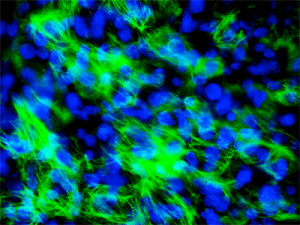 |
| Electrically conditioned human cardiomyocytes. Striated ultrastructure containing troponin (stained in green) forms around cell nuclei (stained in blue).--Courtesy of Benjamin Lee, Columbia U. |
Scientists researching heart failure have been actively trying to generate heart cells in the lab to resemble what we find in the normal human heart. Now a group from Columbia University School of Engineering and Applied Science show that by applying electrical stimulation to heart cells, from human stem cells in the lab, it's possible to mimic this process more closely.
Gordana Vunjak-Novakovic and her team published their work this month in Nature Communications. Their work addresses the issue of the current state of immaturity of hearts cells derived from human stem cells--an issue that many labs around the world are trying tackle.
In order for these heart cells to be used to replace dying cells in the injured heart they need to be fully "mature," willing to integrate and participate in the beating of the adult heart. Fully mature heart cells (cardiomyocytes) could also be used for drug screening to give a better indication of the benefits and risks of a drug.
 |
| Columbia U.'s Gordana Vunjak-Novakovic |
Vunjak-Novakovic teamed up with fellow co-authors George Eng and Benjamin Lee, who grew human stem cell-derived cardiomyocytes and engineered them into 3-D structures. Over the course of one week they applied an electrical stimulus, resembling the electrical conduction of a healthy heart, to these structures and observed improved connectivity and muscular contraction.
"We've made an exciting discovery," says Vunjak-Novakovic. "We applied electrical stimulation to mature these cells, regulate their contractile function, and improve their ability to connect with each other. In fact, we trained the cell to adopt the beating pattern of the heart, improved the organization of important cardiac proteins, and helped the cells to become more adult-like.
"This preconditioning is an important step to generating robust cells that are useful for a wide range of applications including the study of cardiomyocyte biology, drug testing, and stem cell therapy. And we think that our method could lead to the reduction of arrhythmia during cell-based heart regeneration."
They next plan to see whether these conditioned cardiomyocytes have the ability to integrate and behave similar to cardiomyocytes already found in the heart.
- here's the release
- here's the Nature Communications article